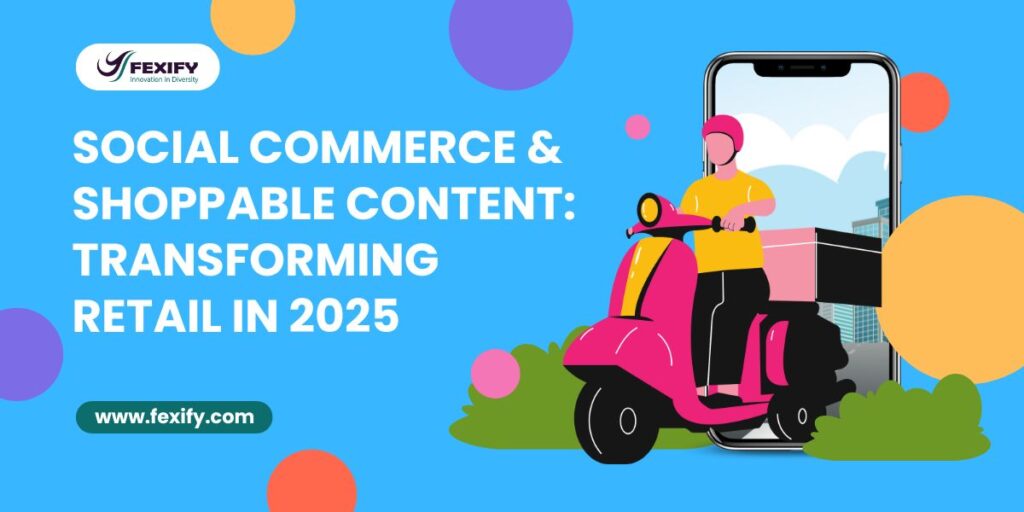Introduction
Social commerce, the fusion of social media and e-commerce has exploded into a $1.2 trillion industry in 2025, with platforms like Instagram, TikTok, and Pinterest leading the charge. By enabling users to discover, interact with, and purchase products without leaving apps, social commerce reduces cart abandonment rates and creates frictionless shopping experiences. This article breaks down the latest trends, strategies, and tools shaping this dynamic landscape.

Key Trends Driving Social Commerce in 2025
- Live Shopping Events:
Live-stream shopping combines entertainment and instant purchasing, driving urgency through real-time interaction. Brands like Fenty Beauty host live events with influencers, answering questions and offering exclusive deals, resulting in $2M sales in a single session 5. Platforms like TikTok Live and Amazon Live provide built-in tools for hosting these events. - Augmented Reality (AR) & Virtual Try-Ons:
AR bridges the gap between online and offline shopping. For example, Sephora’s Virtual Artist lets users test makeup shades via AR, boosting engagement and reducing returns. Snapchat and Instagram also offer AR filters for virtual product trials, enhancing customer confidence. - AI-Driven Personalization:
Platforms like Instagram and TikTok use AI to analyze user behavior, delivering tailored product recommendations. Chatbots powered by natural language processing (NLP) guide customers from discovery to checkout, as seen in H&M’s AI-driven style advisor. - User-Generated Content (UGC):
UGC builds trust, with 92% of consumers trusting peer reviews over branded content. Brands like Glossier and Apple leverage hashtag campaigns (e.g., #ShotoniPhone) to encourage authentic customer stories, driving conversions. - Seamless In-App Checkouts:
Platforms now integrate payment gateways directly into posts, reducing cart abandonment. Instagram’s shoppable tags and TikTok’s in-app checkout streamline purchases, shortening the buyer journey.
Top Social Commerce Platforms
- Instagram Shopping: Ideal for visual industries (fashion, beauty), Instagram allows product tagging in posts, Stories, and Reels. Its Explore page uses AI to recommend products, driving 83% of shoppers to discover new brands.
- TikTok Shop: Viral trends and shoppable videos dominate TikTok, with brands like P Louise generating $2M in 12 hours via live streams.
- Pinterest Shopping: Shoppable Pins cater to intent-driven shoppers, offering inspiration-to-purchase paths for home decor and DIY niches.
- Third-Party Tools: Platforms like LTK and LoudCrowd enable creators to curate shoppable content, while Bazaarvoice integrates reviews into product pages for social proof.
Benefits of Social Commerce
- Higher Conversions: Shoppable posts reduce steps to purchase, increasing conversion rates by 29%.
- Enhanced Brand Loyalty: Interactive experiences (e.g., live Q&As, AR trials) deepen customer relationships.
- Global Reach: Social platforms like TikTok and WeChat Mini Programs connect brands with billions of users, including niche markets like China.
Challenges to Address
- Data Privacy: Stricter regulations (GDPR, CCPA) require transparent data practices. Brands must prioritize zero-party data (e.g., quizzes, loyalty programs) to maintain trust.
- Content Saturation: Standing out requires niche targeting (e.g., vegan meal prep tutorials) and cross-platform repurposing (e.g., TikTok to YouTube Shorts).
Future Outlook
By 2025, social commerce will account for 17% of global e-commerce sales, driven by:
- Advanced AR/VR Integration: Virtual store walkthroughs and avatar-based try-ons.
- AI-Powered Analytics: Predictive tools to refine campaigns and personalize shopping journeys.
- Expansion into Messaging Apps: WhatsApp and Facebook Messenger will enable conversational commerce via chatbots.
Conclusion
Social commerce is no longer optional, it’s essential for brands aiming to thrive in 2025. By adopting shoppable content, live streams, and AR, businesses can meet consumers where they are: scrolling, engaging, and buying in real time. Platforms like Instagram and TikTok, combined with UGC and AI, offer unparalleled opportunities to convert passive viewers into loyal customers.
Ready to Go Viral? Explore Fexify’s Video Marketing Services and start creating scroll-stopping content today.
Learn more:
Become a Digital Marketing Expert today
Wish to become part of something great? Join GoGreen Technologies
